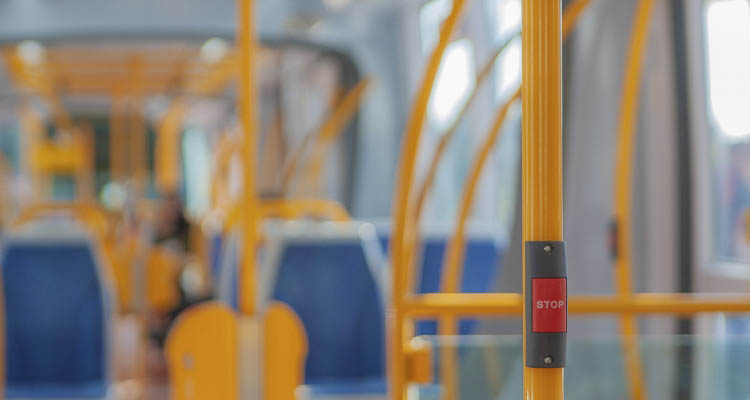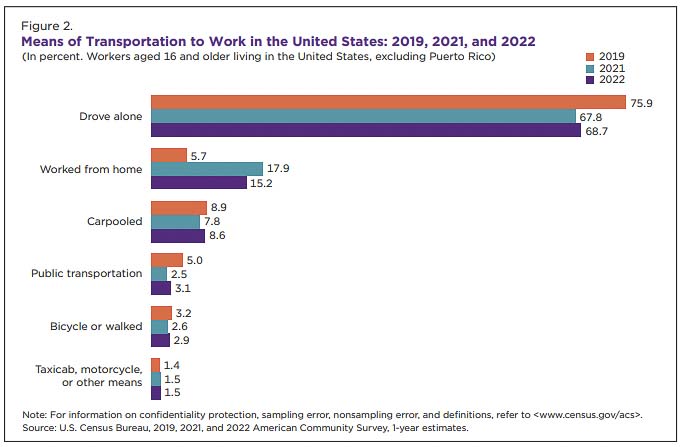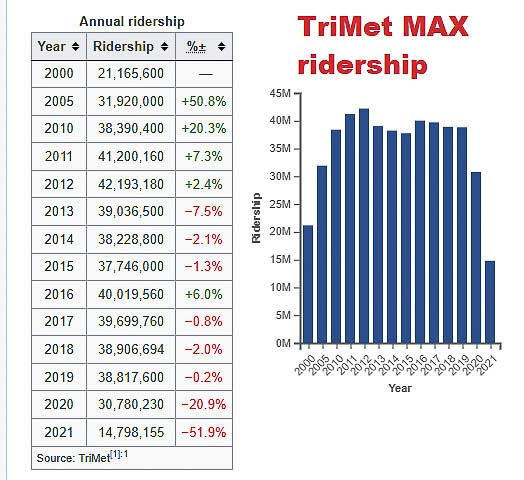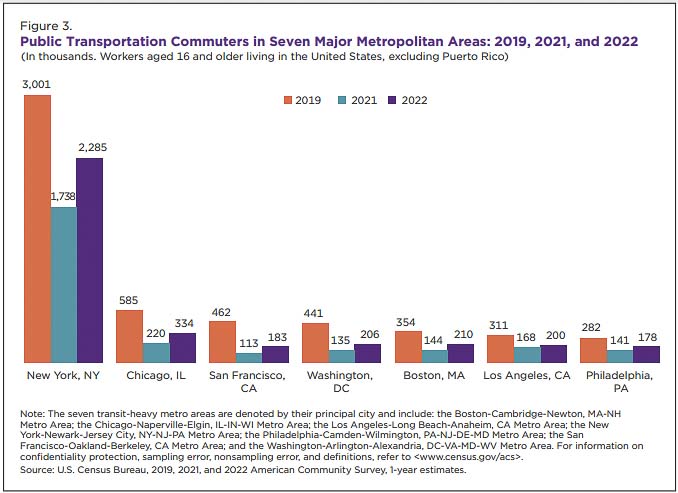
Is expensive high capacity transit needed for the Interstate Bridge project?
John Ley
for Clark County Today
The US Census Bureau reports that people using mass transit to commute to work remains 38 percent below pre pandemic levels. Put another way, 97 of 100 Americans do not use mass transit for daily trips. “About 70 percent of metro-based transit commuters (public transportation commuters living in U.S. metro areas) lived in one of the seven transit-heavy metro areas: Boston, Chicago, Los Angeles, New York, Philadelphia, San Francisco, and Washington, DC.,” they report.
Nationally, more workers drove alone to work in 2022 than in 2019, and the number traveling by public transportation did not increase between 2021 and 2022. People biking is just 2.9 percent, carpooling is 8.6 percent. Both remain below 2019 levels. Locally, a 2022 OHSU employee survey found 9 in 10 respondents use telework to some degree, and 8 in 10 drive alone.
Washington state was one of two states where over 20 percent of workers were home-based. Oregon is one of 15 states where 16 percent to 19.9 percent worked from home. “The share of people working from home roughly tripled during the pandemic’s initial phase,” they report. It increased from 5.7 percent of workers in 2019 to 17.9 percent in 2021, but then declined to 15.2 percent of workers in 2022 as pandemic restrictions came to an end.
Here in the Portland metro area, TriMet data mirrors the national trend of reduced transit ridership. In March 2024, ridership remained 34 percent below pre pandemic levels and about half its 2012 peak. At C-TRAN, ridership was down nearly 37 percent at the end of 2022 compared to pre pandemic ridership. Furthermore, C-TRAN ridership peaked in 1999 at 7.75 million boardings. They had just 3.97 million boardings on their fixed route system in 2022; 49 percent below the peak almost a quarter century ago.

This issue is vitally important to Clark County and Portland metro citizens because the Interstate Bridge Replacement Program (IBR) team members are telling the community that there will be between 26,000 and 33,000 daily transit boardings on the I-5 corridor in 2045. This is likely designed to justify their proposal that $2 billion be spent on a 3-mile MAX light rail extension into Vancouver as part of their $7.5 billion proposal.
C-TRAN offers the only transit service over the Columbia River. The agency experienced a 61 percent drop in passenger boardings on its express bus system over the two years of pandemic lockdowns. The agency shared numbers for nine separate routes traveling over the river for the 2019 to 2021 years. In 2019, it had 1.4 million boardings which then declined to 555,000 in 2021..
Express Routes crossing the I-5 Bridge saw an average of just 523 daily boardings in 2022, C-TRAN shared with Clark County Today. Express Routes crossing the I-205 bridge saw an average of 273 daily boardings. Overall, C-TRAN carried 14.5 people per hour of service across their entire bus network in 2022, according to its annual report.
For the IBR transit projections to be accurate, daily ridership on the I-5 corridor would have to increase fifty-fold to reach their 26,000 number. It would have to increase 63 times to reach the 33,000 number. One state representative told IBR Administrator Greg Johnson, “I’m f***ed if I take those numbers to my constituents.”
The Oregon Transportation Commission conducted a survey in 2019. They reported people’s top priority (51 percent) for fixing traffic congestion was “expand and improve interstates and interstate bridges.” Another 14 percent wanted to “expand and improve arterials.” Only 11 percent wanted to expand multimodal options. Essentially, two thirds of respondents wanted to add vehicle capacity to reduce traffic congestion.
The IBR’s own community surveys indicate 78 percent of Washington residents and 70 percent of regional residents list traffic congestion and lost time as their top priority for the project.
Yet the IBR’s Locally Preferred Alternative will add no new through lanes to the over-congested I-5 bridge. They are projecting morning travel times will double by 2045 from 29 minutes to 60 minutes. Furthermore, half of rush hour traffic will be moving at zero to 20 miles per hour.
The extension of TriMet’s Yellow Line light rail will not save people time. It travels an average of 14 mph because there is a stop almost every mile on its trip into downtown Portland. Fewer people are working downtown with Portland leading the nation in vacant office space.

Randall O’Toole has been examining transit for decades and is known as the “Anti Planner.” He talks about “strategic misrepresentation” as a form of lying on light rail and these mega projects. He notes they over-project transit ridership and under-estimate costs in a 2022 column, Lie Rail Supporters Keep On Lying.
Almost every light-rail project ever built has cost far more than the original projections. Cost overruns are so systematic that Oxford researcher Bent Flyvbjerg says they are “best explained by strategic misrepresentation, that is, lying.” Other lies included overestimated ridership numbers and the claim that light rail is “high-capacity transit.”
TriMet and Metro (Portland’s regional government) predicted in 2019 that the number of MAX trains crossing the Willamette River into downtown would increase by 50 percent within 15 years. This was used to justify discussions for a $4.5 billion (2019) light rail tunnel under the river. Last fall a 3.5-mile tunnel was included in an ODOT Westside Mobility Improvement Study, but had no price tag.
A 2022 article by Charles Marohn in the publication Strong Towns, shows how the game is played. He calls it “engineering malpractice.” He also labels seeking public input: “engagement theater.”
With over one quarter of the $7.5 billion project being the 3-mile light rail extension, and the price tag of the project scheduled to increase according to Johnson, one might wonder why they don’t consider the cheaper and more flexible alternative of buses. C-TRAN has built two Bus Rapid Transit lines for $50 million each, a small fraction of the $2 billion cost of extending light rail. Furthermore, it would eliminate the “new revenues” (aka taxes) TriMet is demanding from both states for the operations and maintenance of the light rail into Clark County.
Nationally and locally, transit ridership remains significantly depressed. As more people work from home, others seek to work in suburbs instead of downtown. “What is needed is a polycentric transportation system,” says transportation architect Kevin Peterson.
Peterson scrutinized the former Columbia River Crossing traffic data and reported the Interstate Bridge would need 5 lanes in each direction by 2030. It would need 7 lanes in each direction by 2045. The IBR is replacing an over-congested 3-lane bridge with another 3-lane bridge, plus an auxiliary lane for merging.
The Cascade Policy Institute has documented multiple broken promises by TriMet, when it comes to the MAX light rail service. Every time they have failed to meet those promised levels of service or passengers being carried.
TriMet officials promised the Federal Transit Administration (FTA) in their Full-Funding Grant Agreement that Yellow Line peak-hour trains would arrive every 10 minutes and off-peak trains every 15 minutes. The promised service according to the Environmental Impact Statement (EIS) was supposed to reach eight trains during peak hours in 2020, or one train every 7.5 minutes.
The EIS forecasted ridership in the corridor would dramatically increase with the building of the Yellow Line. By 2020, the line’s ridership was expected to have 18,100 average weekday riders. It was 5,290, with a shortfall of 12,810 riders. In March 2024, ridership recovered to 10,880 boardings or 5,440 riders. MAX light rail costs have increased 27.5 percent from a year earlier to $9.73 per boarding.

In 2020, voters rejected Metro’s $5 billion transportation plan which included $2.9 billion for a new Southwest light rail extension from downtown Portland to Tigard and Tualatin. Clark County voters have rejected light rail multiple times at the ballot box.
Will the FTA demand honest transit ridership forecasts in evaluating the project’s proposal? Will the Federal Highway Administration demand honest and current traffic projection numbers? Will the Environmental Impact Statement (EIS) have honest and current data, to properly assess the impacts?
Johnson admitted during a recent Community Benefits Advisory Group meeting that getting updated traffic data was part of the delay in preparing the EIS. The release of the Supplemental Draft EIS has been delayed multiple times.
The Census Bureau reported: “Almost 140 million people in the United States routinely commuted to work in 2022, and more than 20 million worked from home. The commuting experience — or, in the face of home-based work, its absence — is central to the life and well-being of many of these U.S. workers.”
With one out of eight people working from home, is there a need for any “high capacity” mass transit over the Columbia River? National and local ridership trends indicate the answer is no.
Also read:
- WSDOT travel charts are key to Memorial Day weekend adventuresMemorial Day weekend is often the unofficial start of summer and planning ahead now is a great jumpstart to holiday travels.
- Construction beginning on new roundabout at intersection of NE 119th Street and NE 152nd AvenueConstruction is beginning to convert the intersection of Northeast 119th Street and Northeast 152nd Avenue to a single-lane roundabout.
- Three weeks of night time delays on SR 14 and Lieser Road overpass in VancouverTravelers who use State Route 14 through Vancouver in southern Clark County, should plan ahead for three weeks of overnight closures.
- National and local transit ridership down significantly feds reportThe US Census Bureau reports that people using mass transit to commute to work remains 38 percent below pre pandemic levels, particularly evident in the Portland metro area, challenging proposed transit expansion plans despite persistent traffic congestion concerns.
- Opinion: The Interstate Bridge replacement is two years behind scheduleJoe Cortright of the City Observatory reports that the Interstate Bridge project’s Draft SEIS was supposed to be complete in December 2022 — It now won’t be done before December 2024.









